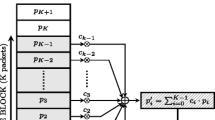Abstract
In our previous work, we presented a brief analysis of the performance of the code block segmentation procedure adopted by the 3GPP LTE Advanced (LTE-A) Standard as part of its physical layer channel coding scheme. Here, a detailed analysis of its performance is offered along with a new approach to the LTE-A code block segmentation procedure. Code block segmentation is a generic procedure applied before turbo encoding whose function is to fragment a large transport block (TB) into smaller code blocks, reducing the decoding latency of turbo decoders (Sun et al. in Integr VLSI J 44(4):305–315, 2011). Analysis showed that only 39 % of all TBs need segmentation. Results based on two different architectures, one focused on a digital signal processors and the other on an field programmable gate array are compared and discussed. A new approach for code block segmentation is presented. This new approach exhibits a speed up of more than 83 times over previous and new approaches presented here.
Access this article
We’re sorry, something doesn't seem to be working properly.
Please try refreshing the page. If that doesn't work, please contact support so we can address the problem.



Similar content being viewed by others
References
Sun, Yang, Cavallaro, Joseph R.: Efficient hardware implementation of a highly-parallel 3GPP LTE/LTE-advance turbo decoder. Integr. VLSI J. 44(4), 305–315 (2011)
3rd Generation Partnership Project: Technical Specifications Series 36 for E-UTRA (Release 10). http://www.3gpp.org
Lenzi, K.G., Bianco Filho, J.A., de Figueiredo, F.A.P.: Code block segmentation hardware architecture for LTE-advanced. IEEE Wireless Communications and Networking Conference (WCNC): PHY, April (2013)
Texas Instruments: Enabling LTE development with TI’s new multicore SoC architecture. Feb (2010)
3rd Generation Partnership Project: 3GPP TS 36.212 version 10.6.0 Release 10: Multiplexing and Channel Coding. July (2012)
Khailany, B. et al.: Exploring VLSI scalability of stream processors. International Conference on High Performance Computer Architecture (HPCA). Feb(2003)
Aricent.: LTE eNodeB PHY Framework. http://www.aricent.com/software/lte-enodeb-phy-framework.html. Accessed 14 Sep 2012
Picochip.: Developing LTE Small Cell with Picochip (MWC2011). http://www.picochip.com (2011)
Ubiquisys. http://www.ubiquisys.com. Accessed 14 Sep 2012
Lenzi, K.G., Bianco Filho, J.A., de Figueiredo, F.A.P., Figueiredo, F.L.: On the performance of code block segmentation for LTE-advanced. IEEE Application (ASAP). Jun (2013)
Xilinx: Virtex-6 Family Overview Datasheet. Jan (2012)
Analog Devices: Blackfin Embedded Processor: ADSP-BF531/ADSP-BF532/ADSP-BF533 Datasheet. Januray (2011)
Motorola: Code Block Segmentation for LTE Channel Coding. R1-071059, 3GPP TSG RAN WG1 #48, Feb. 2007; XP-050105053
R1-074848, Ericsson: CRC Computation Method. 3GPP RAN1#51bis, Jeju, Korea, Nov 05–09, 2007
R1-074473, Ericsson: ETRI, ITRI, LGE, Motorola, Nokia, Nokia Siemens Networks, Nortel, Qualcomm, Samsung, ZTE. TB CRC Generator Polynomial. 3GPP TSG RAN WG1#50b, Shanghai, China, Oct 8–12, 2007
Widrow, B., Kollár, I.: Quantization noise: Roundoff error in digital computation. In: Signal Processing, Control, and Communications. Cambridge University Press, Cambridge (2008)
FemtoForum API: LTE eNB L1 API Definition v1.1. FemtoForum Technical Document. Dec (2010)
3rd Generation Partnership Project: 3GPP TS 36.213 version 10.7.0 Release 10: Physical layer procedures. Oct (2012)
Acknowledgments
The authors thanks the support given to this work, developed as part of the RASFA project, financed by the Fundo de Desenvolvimento das Telecomunicações - FUNTTEL, from the Brazilian Department of Communication, through the partnership no. 01.09.0631.00 with FINEP – Finaciadora de Estudos e Projetos.
Author information
Authors and Affiliations
Corresponding author
Rights and permissions
About this article
Cite this article
Lenzi, K.G., Figueiredo, F.A.P., Bianco Filho, J.A. et al. Fully Optimized Code Block Segmentation Algorithm for LTE-Advanced. Int J Parallel Prog 43, 988–1003 (2015). https://doi.org/10.1007/s10766-014-0324-7
Received:
Accepted:
Published:
Issue Date:
DOI: https://doi.org/10.1007/s10766-014-0324-7




